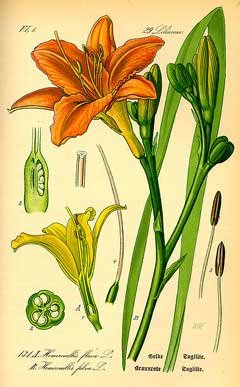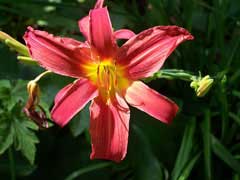 |
|
http://commons.wikimedia.org/wiki/File:Illustration_Hemerocallis_fulva0.jpg |
 |
| http://de.wikipedia.org/wiki/Benutzer:Callipides |
Translate this page:
Summary
Physical Characteristics

 Hemerocallis species is a PERENNIAL growing to 1.2 m (4ft).
Hemerocallis species is a PERENNIAL growing to 1.2 m (4ft).
It is not frost tender. It is in flower from July to September. The species is hermaphrodite (has both male and female organs) and is pollinated by Insects.
Suitable for: light (sandy), medium (loamy) and heavy (clay) soils and can grow in heavy clay soil. Suitable pH: mildly acid, neutral and basic (mildly alkaline) soils. It can grow in semi-shade (light woodland) or no shade. It prefers dry or moist soil.
UK Hardiness Map
US Hardiness Map
Synonyms
Plant Habitats
Edible Uses
Edible Parts: Shoots
Edible Uses:
Leaves and young shoots - cooked. They have a delicious sweet flavour, but must be consumed when very young or else they become fibrous[K]. Flowers and flower buds - raw or cooked. The quality varies from cultivar to cultivar. All are pleasantly sweet and crunchy, though some leave an unpleasant after-taste in the mouth. In general, those with yellow or scented flowers are less desirable than those with brown to red flowers[K]. Root - raw or cooked.
References More on Edible Uses
Medicinal Uses
Plants For A Future can not take any responsibility for any adverse effects from the use of plants. Always seek advice from a professional before using a plant medicinally.
The juice of the roots is an effective antidote in cases of arsenic poisoning[205]. A tea made from the boiled roots is used as a diuretic[205].
References More on Medicinal Uses
The Bookshop: Edible Plant Books
Our Latest books on Perennial Plants For Food Forests and Permaculture Gardens in paperback or digital formats.

Edible Tropical Plants
Food Forest Plants for Hotter Conditions: 250+ Plants For Tropical Food Forests & Permaculture Gardens.
More

Edible Temperate Plants
Plants for Your Food Forest: 500 Plants for Temperate Food Forests & Permaculture Gardens.
More

More Books
PFAF have eight books available in paperback and digital formats. Browse the shop for more information.
Shop Now
Other Uses
The tough dried foliage is plaited into cord and used for making footwear[205].
Special Uses
References More on Other Uses
Cultivation details
There are many cultivars of garden origin in this genus that cannot be placed as part of a species simply because they are the result of many generations of hybridization. In general they all have edible flowers, young shoots and roots, though the quality will vary considerably from cultivar to cultivar. The following notes are general for the genus. Succeeds in most soils[1], including dry ones, preferring a rich moist soil[205]. Grows well in heavy clay soils. Succeeds in short grass if the soil is moist[1]. Succeeding in sun or shade, it produces more flowers in a sunny position though these flowers can be shorter-lived in very sunny positions[205]. Prefers a pH between 6 and 7[200]. Hybridizes freely with other members of this genus[200]. Individual flowers are very short-lived, they open in the late afternoon and fade in the following morning[205]. Plants take a year or two to become established after being moved[1]. Plants seem to be immune to the predations of rabbits[233]. The plants are very susceptible to slug and snail damage, the young growth in spring is especially at risk[200].
References Carbon Farming Information and Carbon Sequestration Information
Temperature Converter
Type a value in the Celsius field to convert the value to Fahrenheit:
Fahrenheit:
The PFAF Bookshop
Plants For A Future have a number of books available in paperback and digital form. Book titles include Edible Plants, Edible Perennials, Edible Trees,Edible Shrubs, Woodland Gardening, and Temperate Food Forest Plants. Our new book is Food Forest Plants For Hotter Conditions (Tropical and Sub-Tropical).
Shop Now
Plant Propagation
Seed - sow in the middle of spring in a greenhouse. Germination is usually fairly rapid and good, pot up the seedlings into individual pots when they are large enough to handle. Grow the plants on for their first winter in a greenhouse and plant out in late spring[K]. Hemerocallis cultivars will not breed true from seed, though seedlings do offer an opportunity to develop superior varieties for eating[K]. Division in spring or after flowering in late summer or autumn[200]. Division is very quick and easy, succeeding at almost any time of the year[K]. Larger clumps can be replanted direct into their permanent positions, though it is best to pot up smaller clumps and grow them on in a cold frame until they are rooting well. Plant them out in the spring.
Other Names
If available other names are mentioned here
Native Range
Coming Soon
Weed Potential
Right plant wrong place. We are currently updating this section.
Please note that a plant may be invasive in one area but may not in your area so it's worth checking.
Conservation Status
IUCN Red List of Threatened Plants Status :

Growth: S = slow M = medium F = fast. Soil: L = light (sandy) M = medium H = heavy (clay). pH: A = acid N = neutral B = basic (alkaline). Shade: F = full shade S = semi-shade N = no shade. Moisture: D = dry M = Moist We = wet Wa = water.
Now available:
Food Forest Plants for Mediterranean Conditions
350+ Perennial Plants For Mediterranean and Drier Food Forests and Permaculture Gardens.
[Paperback and eBook]
This is the third in Plants For A Future's series of plant guides for food forests tailored to
specific climate zones. Following volumes on temperate and tropical ecosystems, this book focuses
on species suited to Mediterranean conditions—regions with hot, dry summers and cool, wet winters,
often facing the added challenge of climate change.
Read More
Expert comment
Author
.
Botanical References
200
Links / References
For a list of references used on this page please go here
Readers comment
| Add a comment |
|
If you have important information about this plant that may help other users please add a comment or link below. Only comments or links that are felt to be directly relevant to a plant will be included. If you think a comment/link or information contained on this page is inaccurate or misleading we would welcome your feedback at [email protected]. If you have questions about a plant please use the Forum on this website as we do not have the resources to answer questions ourselves.
* Please note: the comments by website users are not necessarily those held by PFAF and may give misleading or inaccurate information.
To leave a comment please Register or login here All comments need to be approved so will not appear immediately.
|
Subject : Hemerocallis species
|
|
|
|